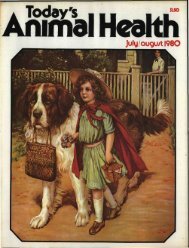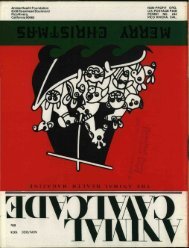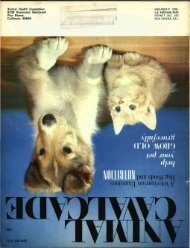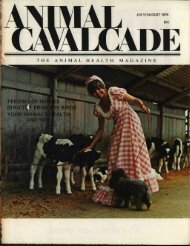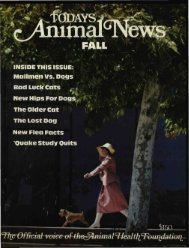aim
July-August 1972 - Animal Health Foundation
July-August 1972 - Animal Health Foundation
- No tags were found...
You also want an ePaper? Increase the reach of your titles
YUMPU automatically turns print PDFs into web optimized ePapers that Google loves.
2 n<br />
comes of age<br />
ESEARCH<br />
by Pat Davis<br />
Aerial view of the Veterinary Virus Research Institute<br />
complex.<br />
Prevention of canine distemper<br />
infectious canine hepatitis, and leptospirosis<br />
. . .<br />
Isolation of five previously unknown<br />
virus and three bacterial diseases<br />
that infect dogs . . .<br />
Development of the first combined<br />
live virus vaccine for animals and the<br />
first heterotypic (non-specific) virus in<br />
the prevention of disease . . .<br />
Design of a model disease-free kennel<br />
. . .<br />
The scientific landmarks listed<br />
above and a score of others are the<br />
result of projects originated and implemented<br />
at the Veterinary Virus Research<br />
Institute at Cornell University<br />
in Ithaca, New York. It probably is<br />
responsible for more advances in veterinary<br />
medicine than any other one<br />
source.<br />
The site of these remarkable<br />
achievements is a cluster of compact<br />
flat-roofed buildings at the end of a<br />
winding road atop Snyder Hill, some<br />
two miles from the Cornell campus.<br />
The laboratories and kennels sit unobtrusively<br />
among the pine trees and the<br />
personnel look out over the<br />
deep-wooded mountains and valleys<br />
into which the university is built.<br />
The setting is serene; the accom-<br />
24<br />
plishments spectacular. Such was the<br />
hope when the Veterinary Virus Research<br />
Institute was founded<br />
twenty-one years ago.<br />
In the Fall of 1950 the Institute was<br />
established in connection with the<br />
New York State Veterinary College at<br />
Cornell; incorporated was the Cornell<br />
Research Laboratory for Diseases of<br />
Dogs, to be supported entirely by<br />
funds contributed for its development.<br />
Thus, the objectives were broadened<br />
to encompass any problem relating to<br />
dog health.<br />
In its first year the Institute was<br />
granted the land and some of the<br />
buildings on Synder Hill. These<br />
became the first laboratories. Also in<br />
1950 a gift from the Gaines Dog<br />
Research Center made possible construction<br />
of the disease-free kennel.<br />
In 1968 a new wing was dedicated,<br />
giving the Institute its present<br />
H-shaped complex, consisting of the<br />
original and new laboratory facilities<br />
and an isolation unit. There are about<br />
fifty employees, in total, including<br />
nine investigators currently representing<br />
areas of specialization in virology,<br />
bacteriology, biochemistry, nutrition,<br />
ophthalmology, serology, immunology,<br />
and electron microscopy.<br />
The Gaines Kennels remain an<br />
essential part of the establishment;<br />
world famous and precedent setting in<br />
the development and maintenance of a<br />
disease-free dog colony. The original<br />
colony was started with Utters born by<br />
hysterectomy and hand raised under<br />
sterile conditions. With disease-free<br />
foundation stock thus provided, the<br />
45-50 Beagles kept for breeding are<br />
allowed to whelp their pups naturally.<br />
The dogs lead normal kennel lives<br />
with ample human contact, free access<br />
to outside runs and so on. The<br />
disease-free environment is sustained,<br />
first, by the kennel's location 1800<br />
feet above sea level and, next, its<br />
isolation from centers of human or<br />
animal popula* in. The atmosphere is<br />
as clean as possible. No disease transmitting<br />
organisms are likely to sift into<br />
the kennel from the air above or at<br />
ground level.<br />
Additionally, a thirty-foot perimeter<br />
fence prevents accidental transmission<br />
of disease from stray animals.<br />
Kennel personnel have contact with<br />
the dogs only after showering and<br />
changing clothes in a special dressing<br />
room. Similar precautions are taken<br />
with food and other supplies brought<br />
into the building. And, of course, rigid<br />
sanitation procedures are followed<br />
within and without the kennel.<br />
When the Institute was founded<br />
three viruses were known to infect




